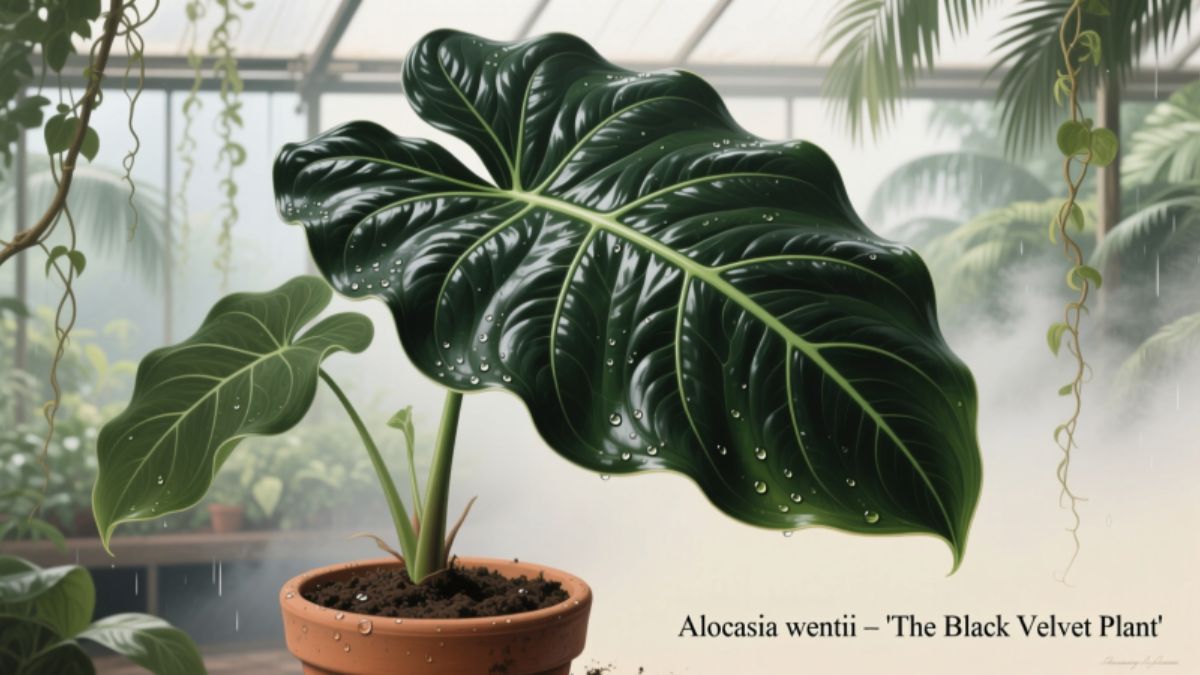If you’re searching for a houseplant that commands attention with its dramatic foliage and architectural elegance, Alocasia Wentii deserves a top spot on your wish list. Often called the “New Guinea Shield” or “Wentii Elephant Ear,” this rare hybrid combines the best traits of its parent species—Alocasia odora and Alocasia sanderiana—to create a plant that’s both visually stunning and surprisingly manageable with the right care. In this comprehensive guide, we’ll walk you through everything you need to know to keep your Alocasia Wentii thriving, from light and water needs to troubleshooting common issues.
Table of Contents
What Is Alocasia Wentii?
Alocasia Wentii is a tropical perennial native to the rainforests of Southeast Asia, particularly New Guinea. It features large, arrow-shaped leaves that can grow up to 18 inches long, with deep green surfaces, silvery undersides, and prominent veining. The leaves emerge upright before arching outward, creating a bold, sculptural silhouette that makes it a favorite among interior designers and plant collectors alike.
Unlike some finicky Alocasias, Wentii strikes a balance between visual drama and relative hardiness—provided you mimic its natural humid, warm, and shaded habitat. While it’s not the easiest plant for absolute beginners, intermediate growers will find it rewarding with consistent care.
Want to hear more tips? Please look at our page for more informative and helpful blog posts.
Ideal Growing Conditions for Alocasia Wentii
To keep your Alocasia Wentii healthy and vibrant, replicate the conditions of its native rainforest floor. Here’s how:
Light Requirements
Alocasia Wentii thrives in bright, indirect light. Place it near an east- or north-facing window where it receives filtered sunlight throughout the day. Avoid direct afternoon sun, which can scorch its delicate leaves. If natural light is limited, supplement with a full-spectrum grow light for 10–12 hours daily.
Watering Needs
This plant prefers consistently moist—but never soggy—soil. Water when the top 1–2 inches of soil feel dry to the touch. Use room-temperature water to avoid shocking the roots, and ensure your pot has drainage holes to prevent waterlogging, which can lead to root rot.
During the active growing season (spring through early fall), water more frequently. In winter, reduce watering slightly as the plant enters a semi-dormant phase.
Humidity and Temperature
High humidity (60% or higher) is essential. Low humidity causes crispy leaf edges and stunted growth. Boost moisture levels by:
- Using a humidifier
- Placing the pot on a pebble tray filled with water
- Grouping it with other plants
- Misting occasionally (though this is less effective than other methods)
Maintain temperatures between 65°F and 85°F (18°C–29°C). Avoid cold drafts, air conditioning vents, and sudden temperature drops below 60°F (15°C).
Soil and Potting
Use a well-draining, airy potting mix rich in organic matter. A blend of:
- 2 parts peat moss or coco coir
- 1 part perlite
- 1 part orchid bark
This mimics the loose, humus-rich forest floor and promotes healthy root aeration. Repot every 1–2 years in spring, choosing a container only 1–2 inches larger in diameter to avoid excess moisture retention.
Fertilization
Feed your Alocasia Wentii monthly during the growing season with a balanced, water-soluble fertilizer (e.g., 10-10-10 or 20-20-20) diluted to half strength. Stop fertilizing in fall and winter when growth slows. Over-fertilization can cause salt buildup and leaf burn—always water before applying fertilizer.
Propagation: How to Multiply Your Alocasia Wentii
Alocasia Wentii propagates best through rhizome division, typically done during repotting in spring.
Steps:
- Gently remove the plant from its pot and shake off excess soil.
- Locate healthy rhizomes with at least one growth node or small leaf shoot.
- Use a sterilized knife to separate the rhizome section.
- Plant each division in fresh, well-draining soil.
- Keep the soil moist and place in warm, humid conditions with indirect light.
New growth usually appears within 4–6 weeks. Avoid leaf or stem cuttings—they won’t root successfully, as Alocasias grow from underground rhizomes or corms.
Common Problems and Solutions
Even with attentive care, Alocasia Wentii may encounter issues. Here’s how to diagnose and fix them:
Yellowing Leaves
- Cause: Overwatering, poor drainage, or natural leaf shedding.
- Fix: Check soil moisture. If soggy, repot with fresh mix and trim rotted roots. Allow the topsoil to dry slightly between waterings.
Brown, Crispy Leaf Edges
- Cause: Low humidity or inconsistent watering.
- Fix: Increase ambient humidity and maintain consistent soil moisture.
Drooping Leaves
- Cause: Underwatering, low light, or root stress.
- Fix: Water thoroughly if soil is dry. Ensure adequate light and inspect roots for damage.
Pests
Watch for spider mites, mealybugs, and aphids, especially in dry conditions.
- Prevention: Wipe leaves regularly with a damp cloth.
- Treatment: Apply insecticidal soap or neem oil every 5–7 days until pests disappear.
Leaf Spot or Fungal Issues
- Cause: Water sitting on leaves, poor air circulation.
- Fix: Water at the base, not the foliage. Improve airflow around the plant and avoid overcrowding.
Alocasia Wentii vs. Other Popular Alocasia Varieties
With so many Alocasia species available, it helps to understand how Wentii compares to its relatives. The table below highlights key differences to help you choose the right plant for your space and skill level.
| Leaf Size | Large (up to 18″) | Medium (8–12″) | Very large (up to 36″) | Small (6–8″) |
| Leaf Color | Deep green, silver underside | Dark green, white veins | Glossy green | Velvety black-green |
| Stem Pattern | Solid green | Solid green | Distinctive zebra stripes | Solid green |
| Humidity Needs | High (60%+) | Moderate to high (50%+) | Very high (70%+) | High (60%+) |
| Light Preference | Bright indirect | Medium to bright indirect | Bright indirect | Medium indirect |
| Growth Habit | Upright, arching | Compact, bushy | Tall, dramatic | Low, rosette-forming |
| Difficulty Level | Intermediate | Beginner-friendly | Intermediate to advanced | Intermediate |
| Cold Tolerance | Low (min 60°F) | Low (min 60°F) | Very low (min 65°F) | Low (min 60°F) |
Why Choose Wentii?
If you want a plant that offers large, eye-catching foliage without the extreme height of Zebrina or the ultra-high humidity demands of some rarer Alocasias, Wentii is an excellent middle ground. Its silvery undersides add dimension, and its growth habit fits well in medium to large indoor spaces.
Styling Tips for Alocasia Wentii in Your Home
Beyond care, Alocasia Wentii serves as a living sculpture. Maximize its impact with these design ideas:
- Statement Corner: Place it in a floor corner near a window with a minimalist pot to let the foliage shine.
- Layered Greenery: Pair with trailing plants like pothos or string of pearls to create visual contrast.
- Modern Aesthetic: Use a matte black or terracotta pot to complement its deep green leaves.
- Bathroom or Kitchen: These naturally humid rooms often provide ideal conditions—just ensure adequate light.
Avoid placing it near heating vents or in dark hallways, as it needs consistent warmth and light to maintain its lush appearance.
Seasonal Care Adjustments
Spring & Summer (Growth Phase):
- Water more frequently.
- Fertilize monthly.
- Rotate the pot weekly for even growth.
- Watch for new leaf unfurling—this is normal and exciting!
Fall & Winter (Dormancy):
- Reduce watering; let soil dry slightly deeper.
- Stop fertilizing.
- Maintain humidity—indoor heating dries the air.
- Don’t panic if growth slows or a leaf yellows; this is natural.
Note: Some Alocasia Wentii plants may go fully dormant in winter, dropping all leaves. Keep the corm dry but not bone-dry, and resume care in spring when new growth appears.
Where to Buy Alocasia Wentii (and What to Look For)
Due to its popularity, Alocasia Wentii is now more widely available—but quality varies. Purchase from reputable nurseries (online or local) that specialize in tropicals. Look for:
- Firm, upright stems
- No yellowing or browning on leaves
- No signs of pests (check leaf undersides)
- Moist—but not waterlogged—soil
Avoid big-box stores where plants may suffer from poor storage conditions. Expect to pay $30–$80 depending on size and source
Final Thoughts: Is Alocasia Wentii Right for You?
Alocasia Wentii rewards patience and attention with unmatched tropical drama. While it demands more than a snake plant or ZZ plant, it’s far less temperamental than some of its Alocasia cousins. If you can provide bright, indirect light, consistent moisture, and high humidity, this plant will thrive and become a centerpiece in your indoor jungle.
Remember: success with Alocasia Wentii hinges on consistency. Small, regular care efforts—checking soil moisture, wiping leaves, monitoring humidity—prevent most problems before they start.
With its striking silhouette, silvery undersides, and architectural presence, Alocasia Wentii isn’t just a houseplant—it’s a living work of art. Give it the environment it craves, and it will repay you with bold, beautiful foliage for years to come.












